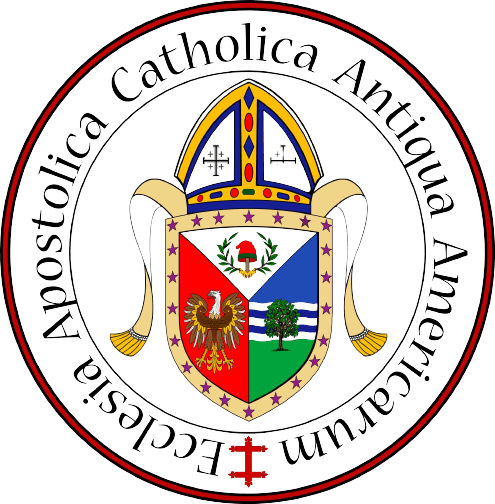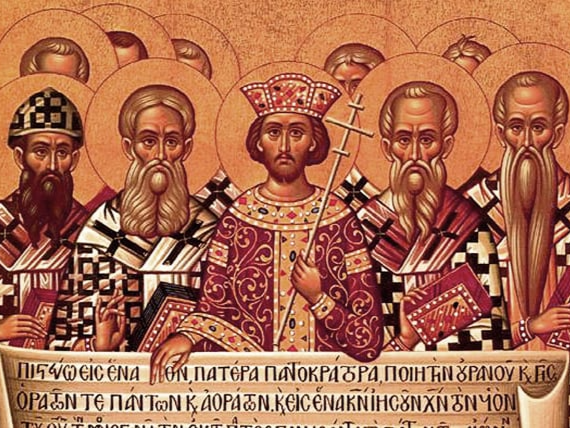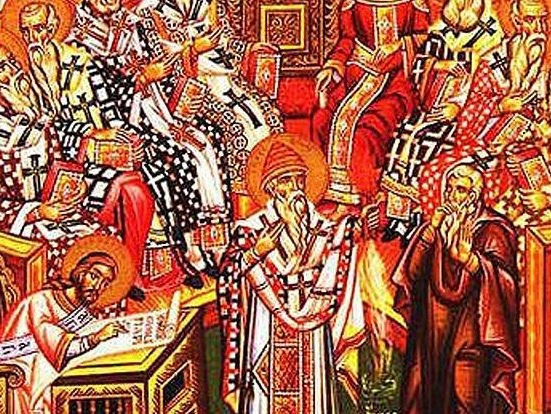The basic beliefs of the Old Catholics are fundamentally the same as contemporary Catholicism: Orthodox Trinitarian Christianity, Profession of Faith (Apostles Creed, Nicene Creed (with or without the Filioque), as well as the Athanasian Creed Quicumque vultâ€), belief in the same seven (7) sacraments the most important being the Holy Eucharist, are of prime importance in obtaining salvation. Considering that the Holy Eucharist has always been the true central point of Catholic worship, we consider it our duty to declare that we maintain with perfect fidelity the ancient Catholic doctrine concerning the Sacrament of the Altar, by believing that we receive the Body and the Blood of our Savior Jesus Christ under the species of bread and wine. The Eucharistic celebration in the Church is neither a continual repetition nor a renewal of the expiatory sacrifice, which Jesus offered once for all upon the Cross; but it is a sacrifice, because it is the perpetual commemoration of the sacrifice offered upon the Cross, and it is the act by which we represent upon earth and appropriate to ourselves the one offering which Jesus Christ makes in Heaven, according to the Epistleto the Hebrews 9:11-12, for the salvation of redeemed humanity, by appearing for us in the presence of God (Hebrews 9:24). The character of the Holy Eucharist being thus understood, it is, at the same time, a sacrificial feast, by means of which the faithful, in receiving the Body and Blood of our Savior, enter into communion with one another (1 Corinthians 10:17).
The teachings are derived from the Holy Bible and sacred tradition including Apostolic Succession. We believes that, while God is one in nature, essence, and being, this one God exists in three divine persons, each identical with the one essence, whose only distinctions are in their relations to one another: the Father's relationship to the Son, the Son's relationship to the Father, and the relations of both to the Holy Spirit, constitute the one God as a Trinity. are baptized in the name (singular) of the Father and of the Son and of the Holy Spirit not three gods, but one God subsisting in three Persons. While sharing in the one divine essence, the Father, Son, and Holy Spirit are distinct, not simply three ""masks"" or manifestations of one Person. The faith of the church and of the individual Christian is based on a relationship with these three Persons of the one God.
We believe that God has revealed himself to humanity as Father to his only-begotten Son, who is in an eternal relationship with the Father: ""No one knows the Son except the Father, just as no one knows the Father except the Son and those to whom the Son chooses to reveal Him."" (Mt. 11:27).
We believe that God the Son, the Divine Logos, the second of the three Persons of God, became incarnate as Jesus Christ, a human being, born of the Virgin Mary. He remained truly divine and was at the same time truly human. In what he said, and by how he lived, he taught all people how to live, and revealed God as Love, the giver of unmerited favors or Graces.
After Jesus' crucifixion and resurrection, his followers, foremost among them the Apostles, spread more and more extensively their faith with a vigor that they attributed to the presence of the Holy Spirit, the third of the three Persons of God, sent upon them by Jesus.
We adhere faithfully to the Rule of Faith laid down by St. Vincent of Lerins in these terms: ""Id teneamus, ubique, quod semper, quod ab omnibus creditum est; hoc est etenim vere proprieque catholicum (We hold that which has been believed everywhere, always, and of all men; for that is truly and properly Catholic)."" For this reason we persevere in professing the faith of the primitive Church, as formulated in the ecumenical symbols and specified precisely by the unanimously accepted decisions of the Ecumenical Councils held in the undivided Church of the first thousand years.
We hope that Catholic theologians, in maintaining the faith of the undivided Church, will succeed in establishing an agreement upon all such questions as caused controversy ever since the Churches became divided. We exhort the priests under our jurisdiction to teach, both by preaching and by the instruction of the young, especially the essential Christian truths professed by all the Christian confessions, to avoid, in discussing controversial doctrines, any violation of truth or charity, and in word and deed set an example to the members of our churches in accordance with the spirit of Jesus Christ our Savior.
By maintaining and professing faithfully the doctrine of Jesus Christ, by refusing to admit those errors, which by the fault of men have crept into the Catholic Church, by laying aside the abuses in ecclesiastical matters, together with the worldly tendencies of hierarchy, we believe that we shall be able to combat efficaciously the great evils of our day, which are unbelief and indifference in matters of religion.
Our Church has a hierarchical structure, meaning a holy ordering (as opposed to a charismatic structure). This hierarchical nature applies to the entire Church, though it is often used to refer only to the ordained ministers of the Church, who belong to one of the three major holy orders: episcopate (bishops), presbyterate (priests), or diaconate (deacons). Some communities also still maintain the former Roman Catholic tradition of tonsure with the minor orders of porter, reader, exorcist, and acolyte. The Bishops, who possess the fullness of Christian priesthood, are as a body (the College of Bishops) the successors of the Apostles and are constituted Pastors in the Church, to be the teachers of doctrine, the priests of sacred worship and the ministers of governance.
The Patriarch, Primates, Archbishops and Bishops are all bishops and members of the Catholic episcopate or college of bishops. We honor, respect, and pray for the Holy Father but we do not acknowledge him as Pontiff or as Vicar of Christ. We hold him as “Primus inter Pares (First Among Equals) and respect his ecclesiastical office of Bishop of Rome. Bishops are assisted by priests and deacons. Parishes, whether territorial or person-based, within a diocese are normally in the charge of a priest, known as the parish priest, administrator, or the pastor. Priests may perform many functions not directly connected with ordinary pastoral activity, such as study, research, teaching or office work. Since we do not receive a paycheck for our pastoral duties, we must therefore earn a living in society in order to pay our bills. Our Deacons, Priests, and Bishops are allowed to marry as are some of the Eastern Rite Catholics and the former Anglican priests who become Roman Catholic (currently around 80). We may also be rectors or chaplains or one of the many other titles and functions allowed us by law. We also have both permanent Deacons and Transitional Deacons – those who are pursuing the Priesthood. Our seminarians go through various training models and utilize both on campus and distance learning modalities. That is why some of us, after ordination to the Diaconate, will not be ordained to the Presbyterate after the more traditional timeframe of six months because we are attending in a part time capacity. We therefore will remain a Deacon until our training reaches a point whereby we have satisfied all of our requirements for the office of the Priesthood. Also, we currently use the Roman Catholic Sacramentary and celebrate the Novus Ordo Rite for Mass in our liturgies; however, there are other sacramentaries and Rites, depending on the community, which can be used provided that it has been approved by College of Bishops and then only on a case-by-case basis.
So, what makes us different than Rome? The major difference identified as the final act that split us from Rome was the question of the infallibility of the Pope. Even though the dogma of infallibility was only based when the Pontiff declared something ex cathedra (those solemn declarations made by him regarding a dogmatic teaching on faith or morals as being contained in divine revelation, or at least being intimately connected to divine revelation) many argued that the only infallible head of the church should be Jesus Christ, therefore, the Pope's judgments would be monitored and even questioned. From this point on, human authority would not interfere with Divine Authority. With the question of Papal Infallibility answered, other reforms followed, such as: participation in Vernacular Mass, married clergy (In fact, there are around 80 former married Episcopal priests who, because of the Pastoral Provision of 1980 instituted by Pope John Paul II, became Roman Catholic priests and continued being married. However, Roman Catholic priests wishing to also get married were excluded from this Pastoral Provision and the only way to become married was to leave their cleric state. Some, decided that they wish to continue in their priestly capacity and therefore have joined the Old Catholic Church. Also, in some jurisdictions, women and gay and lesbians are also permitted to pursue ordination. The view and positions of the Old Catholics paralleled the modernization of American Culture. Many of the issues that divided the two groups were resolved in Vatican II. However, the controversy over Papal Infallibility seems to be the constant divider. We therefore reject the decrees of the so-called Council of the Vatican, which were promulgated on July 18, 1870, concerning the infallibility and the universal Episcopate of the Bishop of Rome, decrees which contradict the faith of the ancient Church, and which destroy its ancient canonical constitution by attributing to the Pope the plenitude of ecclesiastical powers over all Dioceses and over all the faithful.
Today, issues such as beliefs that use of contraception should be decided between and husband and wife, allowing divorced people who remarry back into the church, and allowing all baptized persons the freedom to receive Holy Communion shows our differences when compared to what the Vatican believes. Although the Old Catholic Churches are unknown to many, our importance far outweighs our numerical strengths. The demographics of our congregations are diverse. In fact, The Catholic Apostolic Church in Brazil started by His Excellence, Carlos Duarte Costa, Roman Catholic Bishop of Botucatu in 1945, now boasts over Two Million (2,000,000) members in 14 countries and, here in America, the Polish National Catholic Church (started by a former Roman Catholic Priest around the turn of the20th Century) has around 200 priests and deacons, 12 bishops and 25,000 members. There are many thousands of jurisdictions and communities that espouse the Old Catholic traditions and that range from just a few members to well into the hundreds of thousands and, yes, even the millions. The Church has such a long and extensive history, one would find it odd to consider it a ""new"" religious movement; however, due to its constant change and the different types of congregations that spill from them, the group constantly looks new.
Documentation in Support of the Old Catholic Church:
The Roman Catholic Church has ruled many times on the validity of Old Catholic Holy Orders. We refer our readers to what the Roman Catholic Church teaches in its official document ""DOMINUS IESUS,"" issued during the reign of Pope John Paul II, June 16, 2000, and signed by Joseph Cardinal Ratzinger, Prefect of the Congregation for the Doctrine of the Faith, August 6, 2000, refer to Section IV: Article 17: (Numbered footnote references has been left in for the reader wishing to search this document for themselves if they find it necessary.
""Therefore, there exists a single Church of Christ*, which subsists in the [Roman] Catholic Church, governed by the Successor of Peter and by the Bishops in communion with him.58 The Churches which, while not existing in perfect communion with the [Roman] Catholic Church, remain united to her by means of the closest bonds, that is, by apostolic succession and a valid Eucharist, are true particular Churches.59 Therefore, the Church of Christ is present and operative also in these Churches*, even though they lack full communion with the [Roman] Catholic Church, since they do not accept the [Roman] Catholic doctrine of the Primacy, which, according to the will of God, the Bishop of Rome objectively has and exercises over the entire Church.""60 [*emphasized for clarity]
A Practical Commentary On the Code of Canon Law,"" by the Reverend Stanislaus Woyod, O.F.M., Volume I. Imprimatur: Stephen J. Donahue, Administrator of New York, January 3, 1939. (See Page: 401)""Manual of Dogmatic Theology,"" by A. Tanguerey, translated by Msgr. J. Byrnes, Volume 2, Imprimetur: The Most Reverend Henry J. O'Brien, Archbishop of hartford, Conn. Deaclee Publ. Co., New York, 1959. See page 362
Roman Catholic Dictionary,"" by Addison Arnold, says: ""They have received valid apostolic orders.""
A Catholic Guide to the New Code of Canon Law, by: Thomas P. Doyle, O.P., page 44. "When a Catholic sacred minister is unavailable and there is urgent spiritual necessity, Catholics may receive the Eucharist, penance, or anointing from sacred ministers of non-Catholic denominations whose holy orders are considered valid by the Catholic Church. This includes all Eastern orthodox priests, as wells as priests of the Old Catholic or Polish National Church.""
A Catholic Dictionary,"" by Donald Attwater, bearing the Imprimatur of Cardinal Hayes of New York states: ""Their orders and sacraments are valid.""
Christian Denominations,"" published in 1948 by the Reverend Konrad Algermissen, bearing the Imprimetur of John Cardinal Glennon of St. Louis, Mo., page 363 says: ""The Old (Roman) Catholic Church has received valid episcopal consecration.""
The Far East"" magazine of June 1928, published by the St. Columban Fathers of St. Columbans, Nebraska, in reply to an inquiry about the Old (Roman) Catholic Church, published the replay that ""these apostolic orders are valid."" Recognized also by the Eastern Orthodox Churches as having valid apostolic succession, this same succession was again recognized in 1911 through the labors of Archbishop Arnold Harris Mathew, who signed an Act of Union between the Orthodox Patriarchate of Antioch and a similar Act of Union was concluded with the Orthodox patriarchate of Alexandria in 1912. These Acts of Union have never been questioned and remain as a solid witness to our historic apostolic foundations.
CATHOLIC VISITOR, INC. 1978 - Old Catholic-several groups, including: (1) the Church of Utrecht, which severed relations with Rome in 1724; (2) The National Polish Church in the U.S., which has its origin near the end of the 19th century; (3) German, Austrian and Swiss Old Catholics, who broke away from union with Rome following the First Vatican Council in 1870 because they objected to the dogma of papal infallibility. They accept the first seven ecumenical councils and doctrine formulated before 1054, but reject communion with the pope and a number of other Roman Catholic doctrines and practices. They have a valid priesthood and valid sacraments.
We have no reason to doubt that the Old Catholic Orders are valid. The Apostolic Succession does not depend on obedience to the See of Peter but rather on the objective line of succession from Apostolic sources, the proper matter and form, and the proper intention ... likewise Old Catholic bishops are bishops in Apostolic Succession ... The Old Catholics, like the Orthodox, posses a valid priesthood."" Separated Brethren, William J. Whalen, pp. 204, 248.
A validly consecrated bishop can validly confer all orders from the minor orders to the episcopate inclusively ... For this reason the ordinations performed by the bishops of the Old Catholics are consider valid."" A Practical Commentary on the Code of Canon Law, revised and enlarged edition, by Rev. Stanislaw Woywod, OFM, LLB. Vol. 1, Sec. 881 P. 558.
(Apostolicae Curae) ""...Whenever there is no appearance of simulation on the part of the minister, the validity of the sacrament is sufficiently certain. Every validly consecrated bishop, including heretical, schismatic, simonistic or excommunicated bishops, can validly dispense the Sacrament of Order, provided that he has the requisite intention, and follows the essential external rite (set. Certa). Cf. D 855, 860; CIC 2372.†1952 Fundamentals of Catholic Dogma by Dr. Ludwig Ott, pp. 456.


